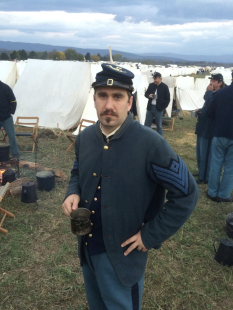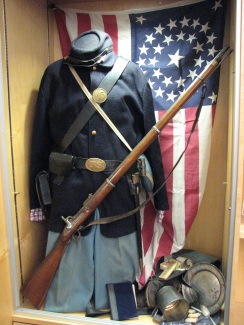Authenticity and Equipment
In the Civil War Reenacting community there is much discussion about authenticity. The degree of authenticity usually depends upon how close reproduction weapons, clothes, utensils, or uniforms are to what would have actually been used. The Third U.S. Regular Infantry Reenactors strive for authenticity but recognize that there are limits based on safety, cost, and availability.
As the demonstration battalion for the School of Brigade Drill at Jefferson Barracks, Missouri, the Third Infantry set the standards for appearance and drill for the entire Army in the 1840s. Today, the reenactors of the Third U.S. Regular Infantry strive to maintain that standard, and to achieve this goal we are constantly conducting research and revising our authenticity standards.
Every Union Infantryman wore a belt set with a cartridge box and sling, cap box, and bayonet scabbard. The leather cartridge box held forty cartridges, paper tubes filled with a Minie ball and black powder issued in small packs of ten. The cartridge box, with a removable liner made of tin that kept cartridges in order, was the safest way to protect the cartridges from sparks that could set off an explosion. Each cartridge box also had a small pouch for a cleaning kit. Union Soldiers carried sixty to eighty rounds of ammunition. Extra cartridges that did not fit into the cartridge box were carried in pockets or a knapsack. The cap box, a small leather pouch worn on the front of the belt, held percussion caps, which had to be handled carefully because they were also very explosive. Soldiers carried a bayonet in a black leather scabbard on their left hip.
Weapons - 1855 or 1861 Springfield rifle musket with oiled leather sling. Members who own 1853 Enfield rifle muskets will not be required to immediately replace them, but new members are required to purchase one of the approved Springfield models.
Bayonet and Scabbard - The Springfield scabbard is the standard, regardless of which rifle musket is carried. Modern markings, i.e. "India" should be removed from bayonets. The scabbard will be of stiff black leather with a brass end piece securely fastened. The two-rivet pattern of 1859 is preferred, as it is correct for the entire period of 1860-1865.
Canteen - The 1858 pattern tin smoothside canteen with oiled leather strap and woolen cover of jean, dark blue or sky blue. Stainless steel is not acceptable.
Haversack - Painted black canvas, with leather closure and muslin liner.
Mess kit - Tin plate, tin cup, fork, spoon and knife. All-in-one knife-fork-spoon kits were common, but avoid the stainless steel sets.
Poncho or gum blanket - Look for correct, small brass grommets.
Blanket - Gray or brown wool with black end stripes and no edge binding.
Tent - For early war, Common tent ("wedge tent," "A tent"). The shelter tent ("dog tent") is preferred for post-1862 scenarios
Optional equipment
- Sky blue kersey greatcoat (overcoat)
- Small skillet and/or coffee boiler
- Knapsack
- Candles
- Ground cloth
Modern rifle cleaning equipment will not be used in camp. The Regulations specified "a wooden rod with a loop in one end," while the Ordnance Manual calls for using a wiper ("worm") attached to the threaded end of the Springfield rammer.
Modern brass cleaners such as Brasso, Never-Dull and Flitz will not be used in camp. Soldiers of the period used white vinegar, ash, charcoal and water, rottenstone, or even dirt to clean their brass. Besides the farby containers, these cleaners produce a far higher shine - which is also farby. Brass should only be yellow in color, not polished to a mirror finish.
Camp stools, chairs, hay or straw bales will be kept off the company street. Modern cigarettes will not be smoked on the company street.
The military discipline, proper uniform and deportment at reenactment events will begin at 6 AM on Saturday morning and end at 5 PM on Sunday afternoon unless altered by the military commander at the event.





